INFINITI JX 2013 Towing Guide
Manufacturer: INFINITI, Model Year: 2013, Model line: JX, Model: INFINITI JX 2013Pages: 25, PDF Size: 0.42 MB
Page 1 of 25
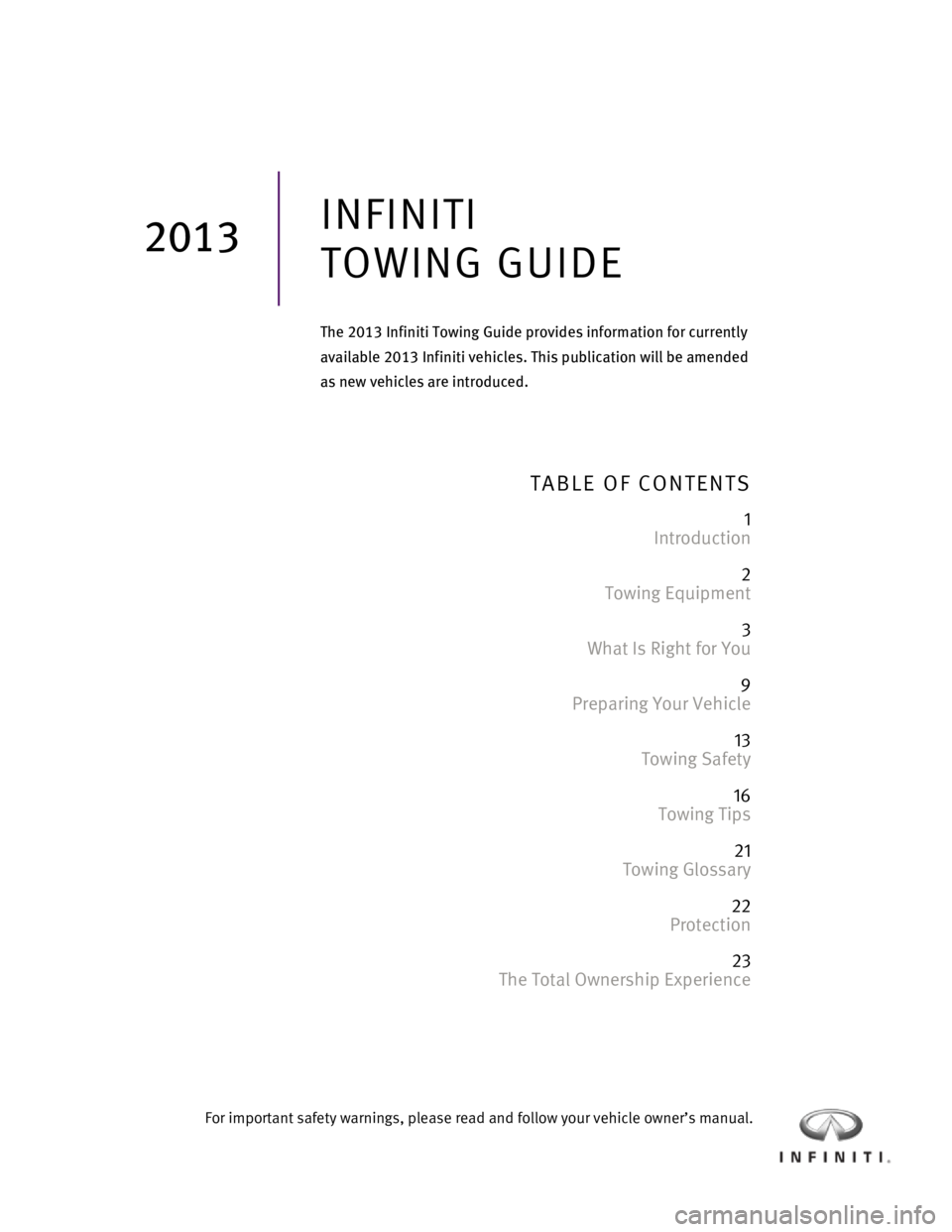
TABLE OF CONTENTS
1
Introduction
2
Towing Equipment
3
What Is Right for You
9
Preparing Your Vehicle
13
Towing Safety
16
Towing Tips
21
Towing Glossary
22
Protection
23
The Total Ownership Experience
INFINITI
TOWING GUIDE
The 2013 Infiniti Towing Guide provides information for currently
available 2013 Infiniti vehicles. This publication will be amended
as new vehicles are introduced.
2013
For important safety warnings, please read and follow your vehicle owner’s manual.
Page 2 of 25
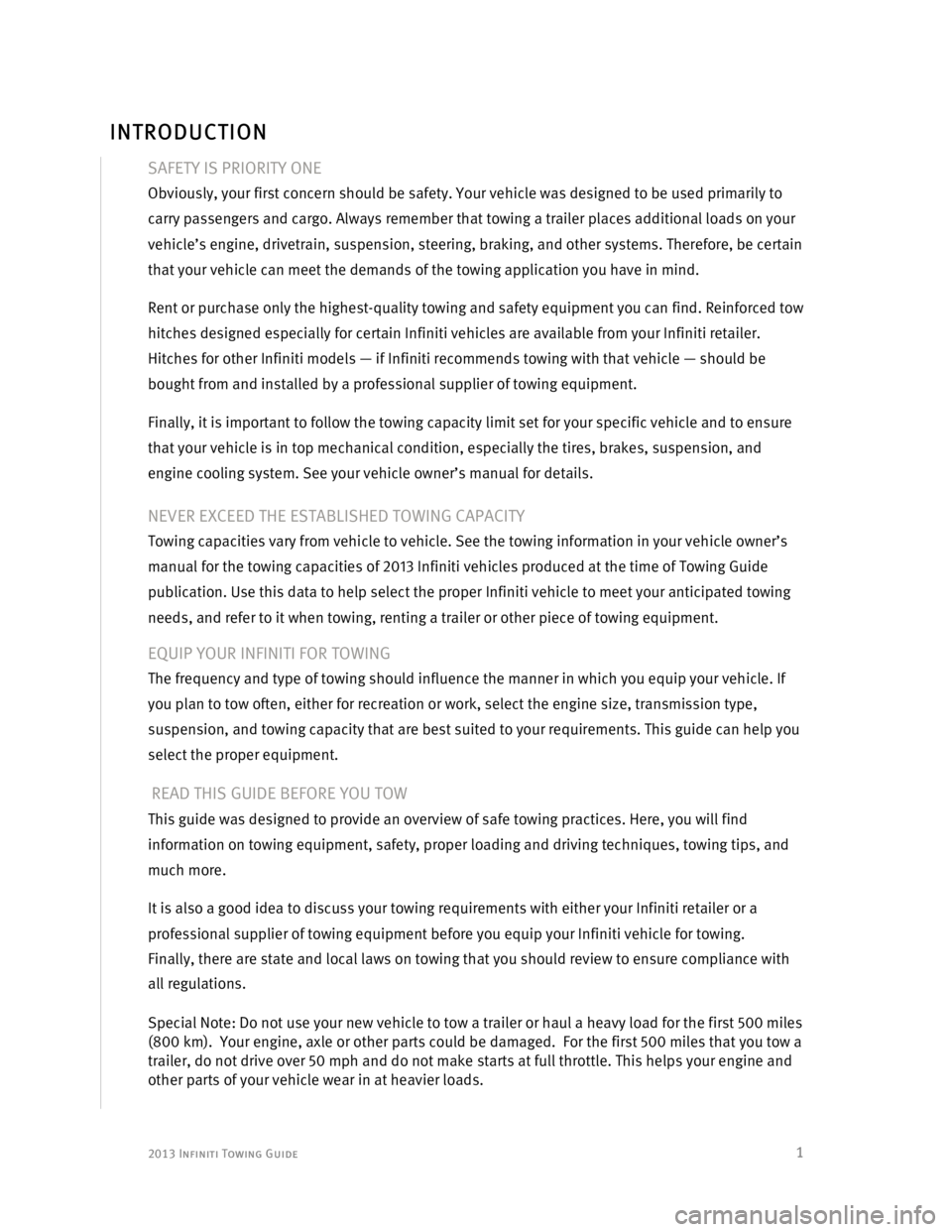
2013 Infiniti Towing Guide
1
SAFETY IS PRIORITY ONE
Obviously, your first concern should be safety. Your vehicle was designed to be used primarily to
carry passengers and cargo. Always remember that towing a trailer places additional loads on your
vehicle’s engine, drivetrain, suspension, steering, braking, and other systems. Therefore, be certain
that your vehicle can meet the demands of the towing application you have in mind.
Rent or purchase only the highest-quality towing and safety equipment you can find. Reinforced tow
hitches designed especially for certain Infiniti vehicles are available from your Infiniti retailer.
Hitches for other Infiniti models — if Infiniti recommends towing with that vehicle — should be
bought from and installed by a professional supplier of towing equipment.
Finally, it is important to follow the towing capacity limit set for your specific vehicle and to ensure
that your vehicle is in top mechanical condition, especially the tires, brakes, suspension, and
engine cooling system. See your vehicle owner’s manual for details.
NEVER EXCEED THE ESTABLISHED TOWING CAPACITY
Towing capacities vary from vehicle to vehicle. See the towing information in your vehicle owner’s
manual for the towing capacities of 2013 Infiniti vehicles produced at the time of Towing Guide
publication. Use this data to help select the proper Infiniti vehicle to meet your anticipated towing
needs, and refer to it when towing, renting a trailer or other piece of towing equipment.
EQUIP YOUR INFINITI FOR TOWING
The frequency and type of towing should influence the manner in which you equip your vehicle. If
you plan to tow often, either for recreation or work, select the engine size, transmission type,
suspension, and towing capacity that are best suited to your requirements. This guide can help you
select the proper equipment.
READ THIS GUIDE BEFORE YOU TOW
This guide was designed to provide an overview of safe towing practices. Here, you will find
information on towing equipment, safety, proper loading and driving techniques, towing tips, and
much more.
It is also a good idea to discuss your towing requirements with either your Infiniti retailer or a
professional supplier of towing equipment before you equip your Infiniti vehicle for towing.
Finally, there are state and local laws on towing that you should review to ensure compliance with
all regulations.
Special Note: Do not use your new vehicle to tow a trailer or haul a heavy load for the first 500 miles
(800 km). Your engine, axle or other parts could be damaged. For the first 500 miles that you tow a
trailer, do not drive over 50 mph and do not make starts at full throttle. This helps your engine and
other parts of your vehicle wear in at heavier loads.
INTRODUCTION
Page 3 of 25
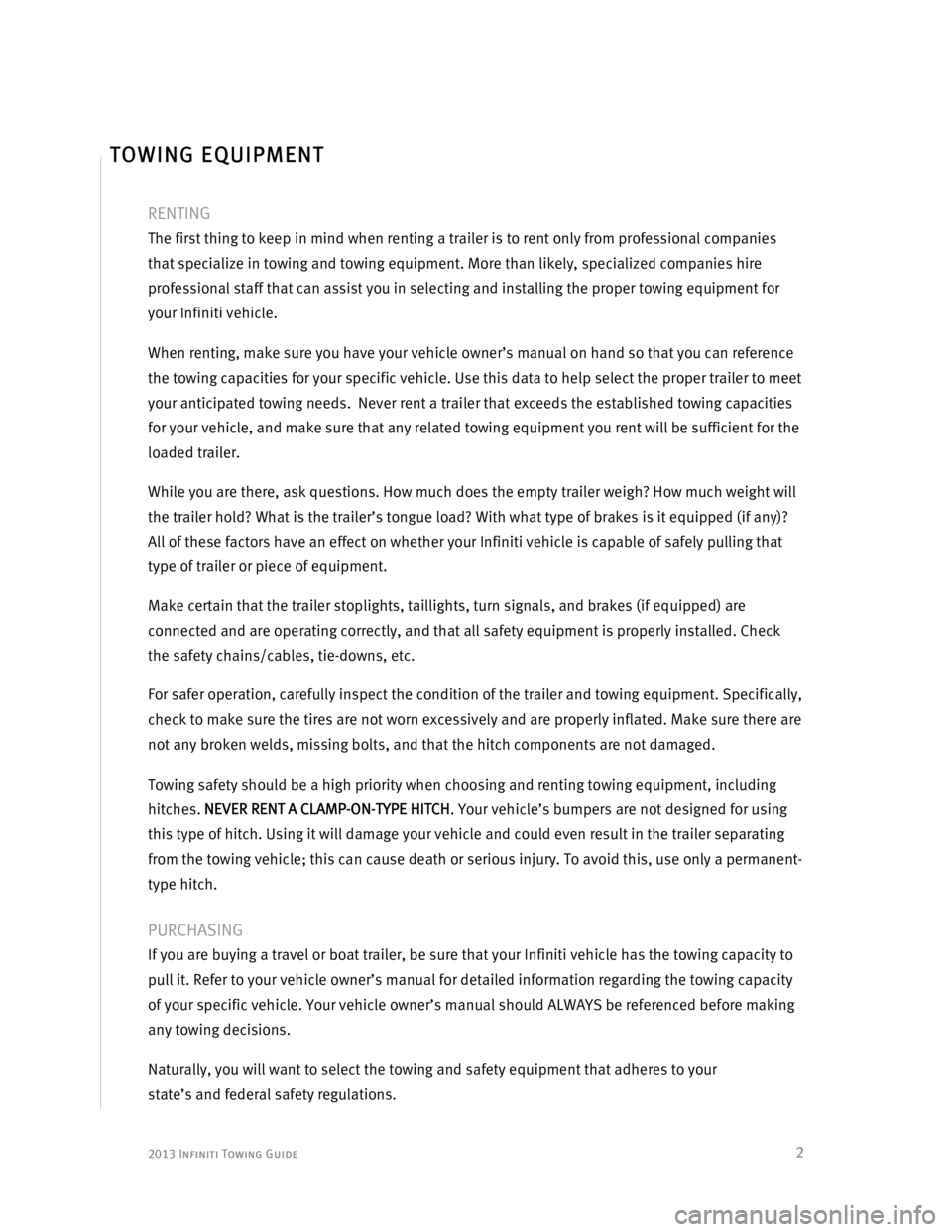
2013 Infiniti Towing Guide
2
RENTING
The first thing to keep in mind when renting a trailer is to rent only from professional companies
that specialize in towing and towing equipment. More than likely, specialized companies hire
professional staff that can assist you in selecting and installing the proper towing equipment for
your Infiniti vehicle.
When renting, make sure you have your vehicle owner’s manual on hand so that you can reference
the towing capacities for your specific vehicle. Use this data to help select the proper trailer to meet
your anticipated towing needs. Never rent a trailer that exceeds the established towing capacities
for your vehicle, and make sure that any related towing equipment you rent will be sufficient for the
loaded trailer.
While you are there, ask questions. How much does the empty trailer weigh? How much weight will
the trailer hold? What is the trailer’s tongue load? With what type of brakes is it equipped (if any)?
All of these factors have an effect on whether your Infiniti vehicle is capable of safely pulling that
type of trailer or piece of equipment.
Make certain that the trailer stoplights, taillights, turn signals, and brakes (if equipped) are
connected and are operating correctly, and that all safety equipment is properly installed. Check
the safety chains/cables, tie-downs, etc.
For safer operation, carefully inspect the condition of the trailer and towing equipment. Specifically,
check to make sure the tires are not worn excessively and are properly inflated. Make sure there are
not any broken welds, missing bolts, and that the hitch components are not damaged.
Towing safety should be a high priority when choosing and renting towing equipment, including
hitches. NEVER RENT A CLAMP-ON-TYPE HITCH. Your vehicle’s bumpers are not designed for using
this type of hitch. Using it will damage your vehicle and could even result in the trailer separating
from the towing vehicle; this can cause death or serious injury. To avoid this, use only a permanent-
type hitch.
PURCHASING
If you are buying a travel or boat trailer, be sure that your Infiniti vehicle has the towing capacity to
pull it. Refer to your vehicle owner’s manual for detailed information regarding the towing capacity
of your specific vehicle. Your vehicle owner’s manual should ALWAYS be referenced before making
any towing decisions.
Naturally, you will want to select the towing and safety equipment that adheres to your
state’s and federal safety regulations.
TOWING EQUIPMENT
Page 4 of 25
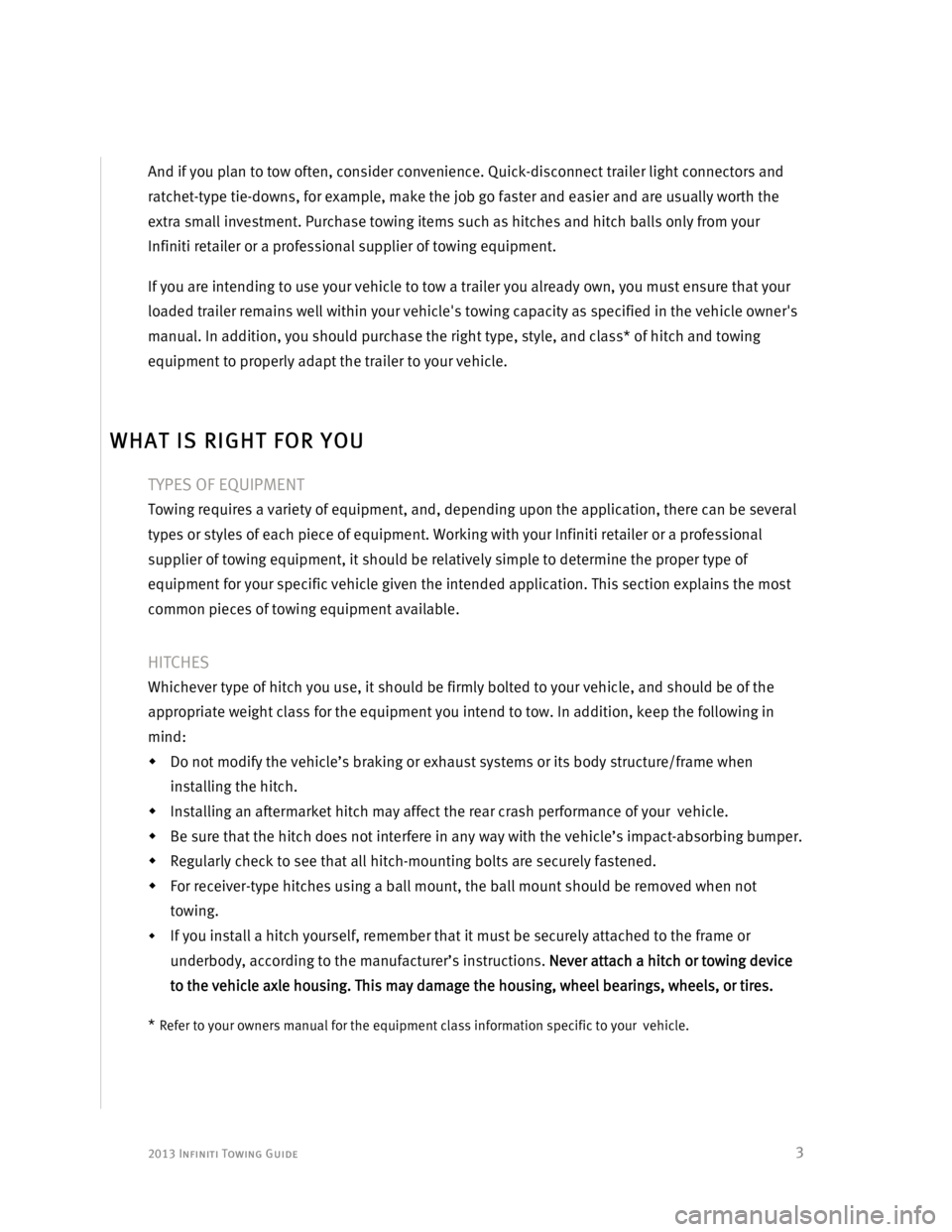
2013 Infiniti Towing Guide
3
And if you plan to tow often, consider convenience. Quick-disconnect trailer light connectors and
ratchet-type tie-downs, for example, make the job go faster and easier and are usually worth the
extra small investment. Purchase towing items such as hitches and hitch balls only from your
Infiniti retailer or a professional supplier of towing equipment.
If you are intending to use your vehicle to tow a trailer you already own, you must ensure that your
loaded trailer remains well within your vehicle's towing capacity as specified in the vehicle owner's
manual. In addition, you should purchase the right type, style, and class* of hitch and towing
equipment to properly adapt the trailer to your vehicle.
TYPES OF EQUIPMENT
Towing requires a variety of equipment, and, depending upon the application, there can be several
types or styles of each piece of equipment. Working with your Infiniti retailer or a professional
supplier of towing equipment, it should be relatively simple to determine the proper type of
equipment for your specific vehicle given the intended application. This section explains the most
common pieces of towing equipment available.
HITCHES
Whichever type of hitch you use, it should be firmly bolted to your vehicle, and should be of the
appropriate weight class for the equipment you intend to tow. In addition, keep the following in
mind:
�Š Do not modify the vehicle’s braking or exhaust systems or its body structure/frame when
installing the hitch.
�Š Installing an aftermarket hitch may affect the rear crash performance of your vehicle.
�Š Be sure that the hitch does not interfere in any way with the vehicle’s impact-absorbing bumper.
�Š Regularly check to see that all hitch-mounting bolts are securely fastened.
�Š For receiver-type hitches using a ball mount, the ball mount should be removed when not
towing.
�Š If you install a hitch yourself, remember that it must be securely attached to the frame or
underbody, according to the manufacturer’s instructions. Never attach a hitch or towing device
to the vehicle axle housing. This may damage the housing, wheel bearings, wheels, or tires.
*
Refer to your owners manual for the equipment class information specific to your vehicle.
WHAT IS RIGHT FOR YOU
Page 5 of 25
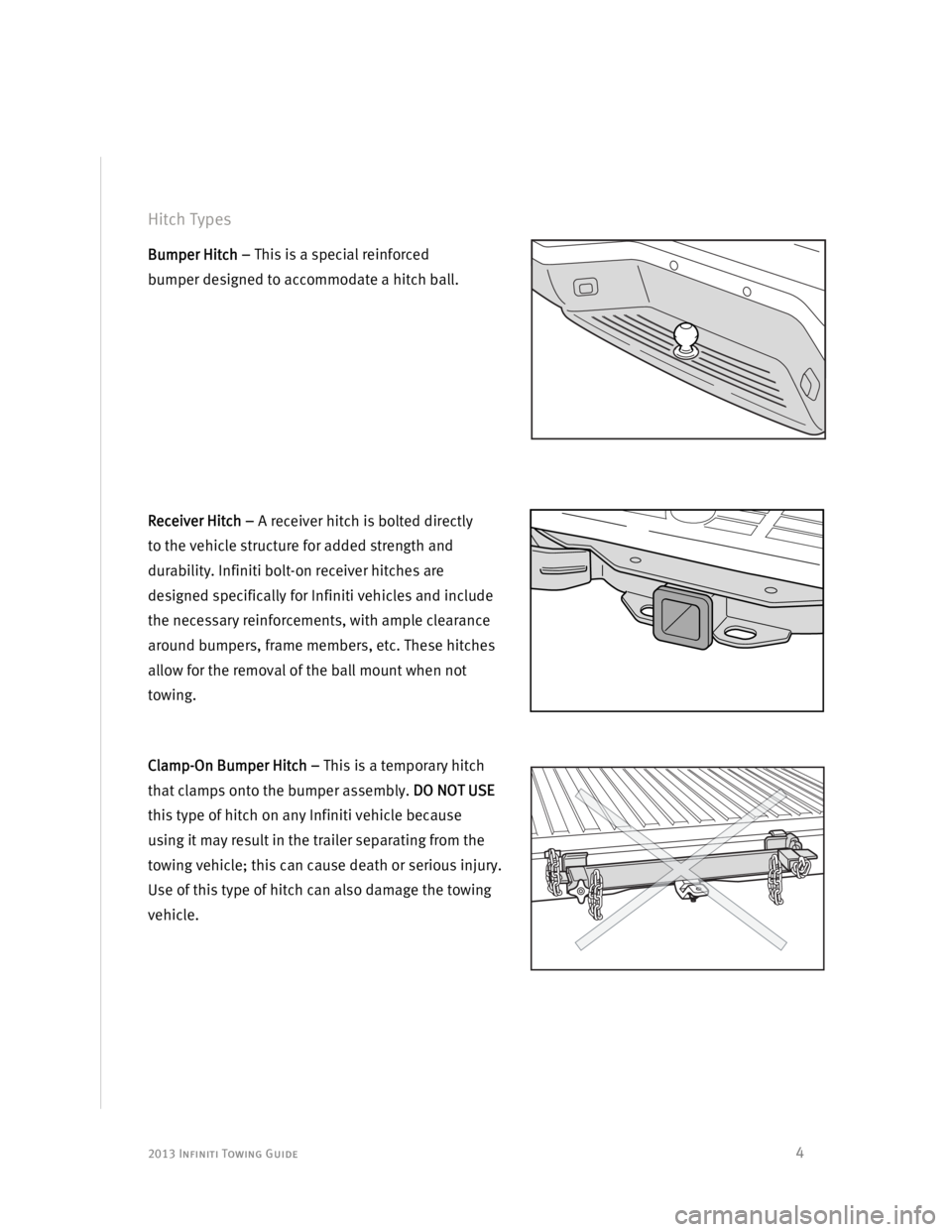
2013 Infiniti Towing Guide
4
Hitch Types
Bumper Hitch – This is a special reinforced
bumper designed to accommodate a hitch ball.
Receiver Hitch – A receiver hitch is bolted directly
to the vehicle structure for added strength and
durability. Infiniti bolt-on receiver hitches are
designed specifically for Infiniti vehicles and include
the necessary reinforcements, with ample clearance
around bumpers, frame members, etc. These hitches
allow for the removal of the ball mount when not
towing.
Clamp-On Bumper Hitch – This is a temporary hitch
that clamps onto the bumper assembly. DO NOT USE
this type of hitch on any Infiniti vehicle because
using it may result in the trailer separating from the
towing vehicle; this can cause death or serious injury.
Use of this type of hitch can also damage the towing
vehicle.
Page 6 of 25
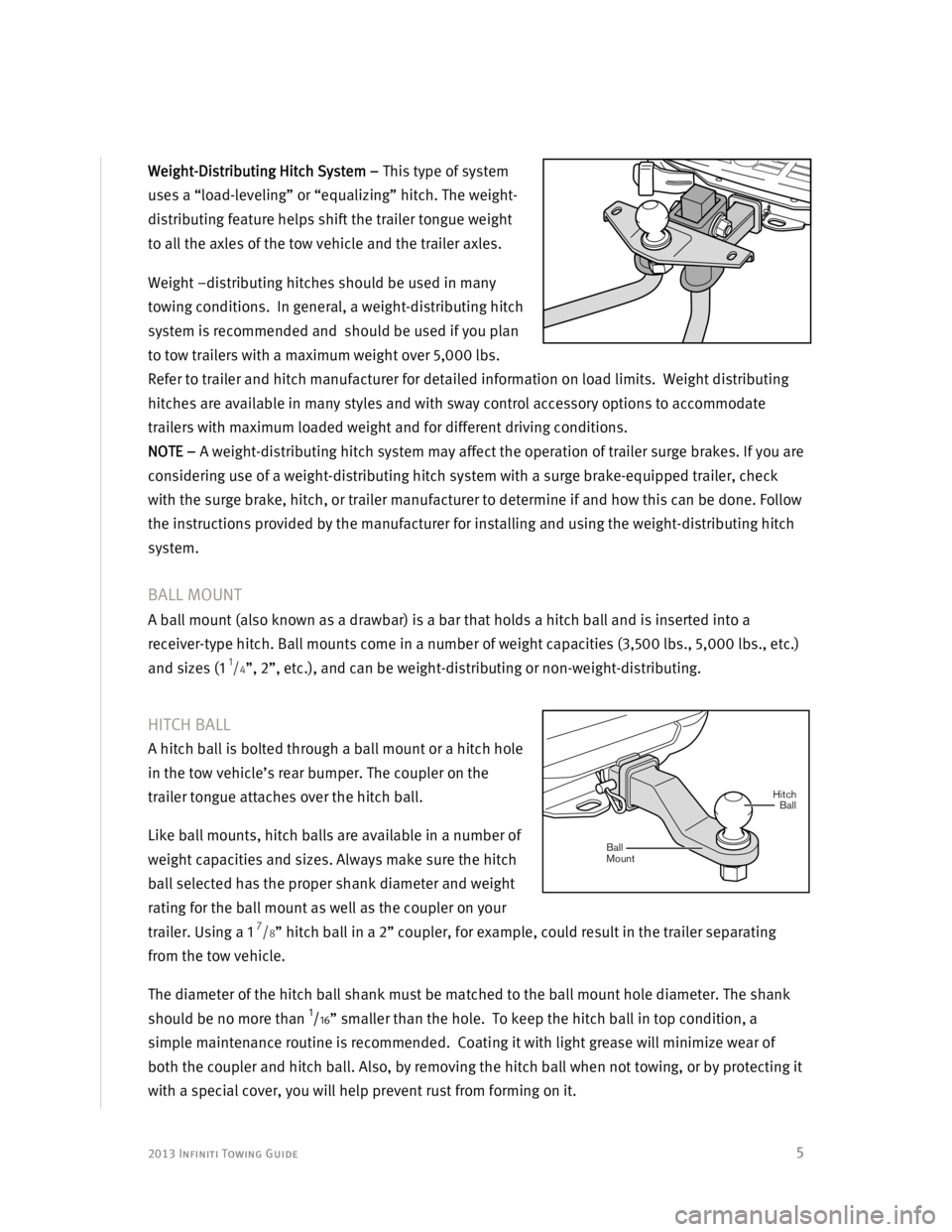
2013 Infiniti Towing Guide
5
Weight-Distributing Hitch System – This type of system
uses a “load-leveling” or “equalizing” hitch. The weight-
distributing feature helps shift the trailer tongue weight
to all the axles of the tow vehicle and the trailer axles.
Weight –distributing hitches should be used in many
towing conditions. In general, a weight-distributing hitch
system is recommended and should be used if you plan
to tow trailers with a maximum weight over 5,000 lbs.
Refer to trailer and hitch manufacturer for detailed information on load limits. Weight distributing
hitches are available in many styles and with sway control accessory options to accommodate
trailers with maximum loaded weight and for different driving conditions.
NOTE – A weight-distributing hitch system may affect the operation of trailer surge brakes. If you are
considering use of a weight-distributing hitch system with a surge brake-equipped trailer, check
with the surge brake, hitch, or trailer manufacturer to determine if and how this can be done. Follow
the instructions provided by the manufacturer for installing and using the weight-distributing hitch
system.
BALL MOUNT
A ball mount (also known as a drawbar) is a bar that holds a hitch ball and is inserted into a
receiver-type hitch. Ball mounts come in a number of weight capacities (3,500 lbs., 5,000 lbs., etc.)
and sizes (1
1/4”, 2”, etc.), and can be weight-distributing or non-weight-distributing.
HITCH BALL
A hitch ball is bolted through a ball mount or a hitch hole
in the tow vehicle’s rear bumper. The coupler on the
trailer tongue attaches over the hitch ball.
Like ball mounts, hitch balls are available in a number of
weight capacities and sizes. Always make sure the hitch
ball selected has the proper shank diameter and weight
rating for the ball mount as well as the coupler on your
trailer. Using a 1
7/8” hitch ball in a 2” coupler, for example, could result in the trailer separating
from the tow vehicle.
The diameter of the hitch ball shank must be matched to the ball mount hole diameter. The shank
should be no more than
1/16” smaller than the hole. To keep the hitch ball in top condition, a
simple maintenance routine is recommended. Coating it with light grease will minimize wear of
both the coupler and hitch ball. Also, by removing the hitch ball when not towing, or by protecting it
with a special cover, you will help prevent rust from forming on it.
Hitch
Mount BallBall
Page 7 of 25
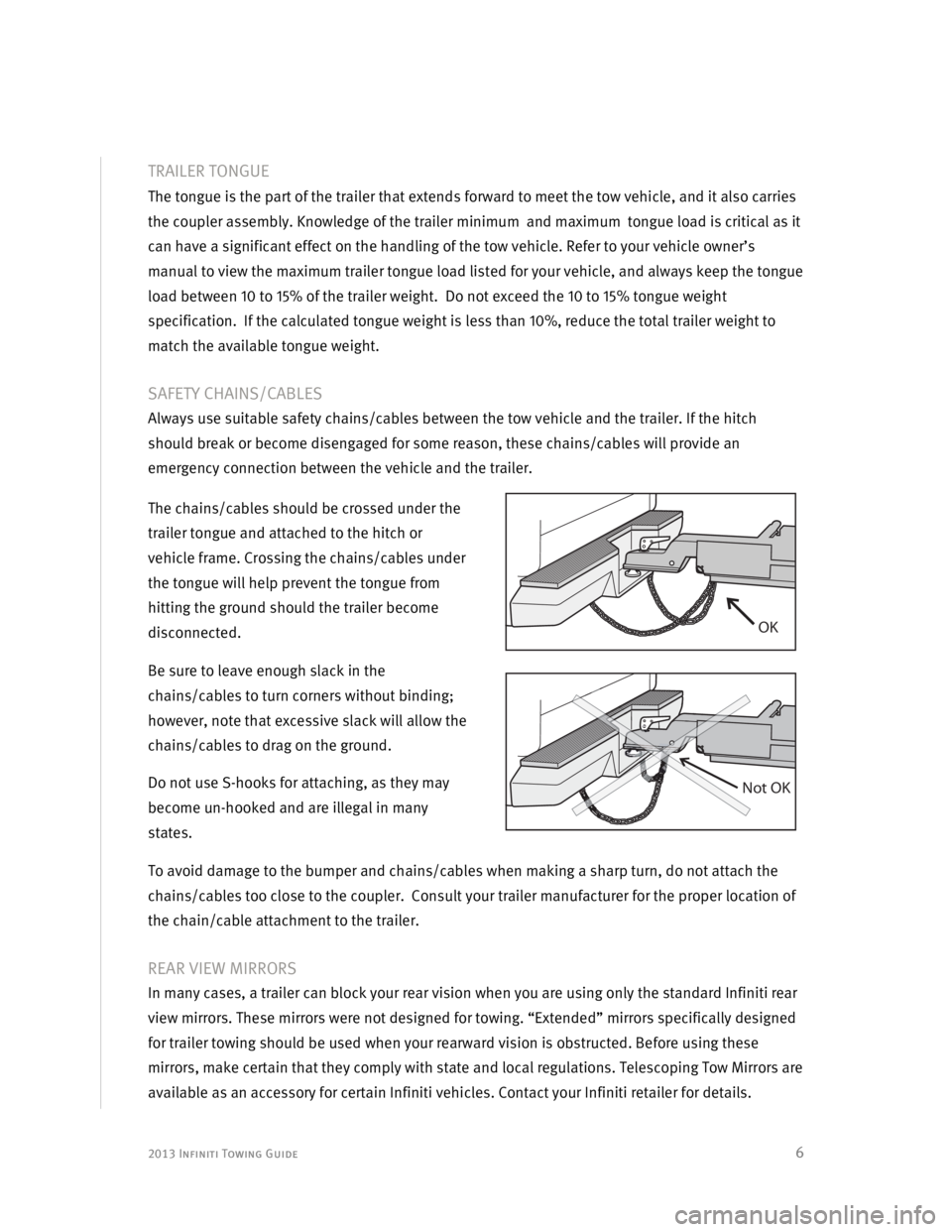
2013 Infiniti Towing Guide
6
TRAILER TONGUE
The tongue is the part of the trailer that extends forward to meet the tow vehicle, and it also carries
the coupler assembly. Knowledge of the trailer minimum and maximum tongue load is critical as it
can have a significant effect on the handling of the tow vehicle. Refer to your vehicle owner’s
manual to view the maximum trailer tongue load listed for your vehicle, and always keep the tongue
load between 10 to 15% of the trailer weight. Do not exceed the 10 to 15% tongue weight
specification. If the calculated tongue weight is less than 10%, reduce the total trailer weight to
match the available tongue weight.
SAFETY CHAINS/CABLES
Always use suitable safety chains/cables between the tow vehicle and the trailer. If the hitch
should break or become disengaged for some reason, these chains/cables will provide an
emergency connection between the vehicle and the trailer.
The chains/cables should be crossed under the
trailer tongue and attached to the hitch or
vehicle frame. Crossing the chains/cables under
the tongue will help prevent the tongue from
hitting the ground should the trailer become
disconnected.
Be sure to leave enough slack in the
chains/cables to turn corners without binding;
however, note that excessive slack will allow the
chains/cables to drag on the ground.
Do not use S-hooks for attaching, as they may
become un-hooked and are illegal in many
states.
To avoid damage to the bumper and chains/cables when making a sharp turn, do not attach the
chains/cables too close to the coupler. Consult your trailer manufacturer for the proper location of
the chain/cable attachment to the trailer.
REAR VIEW MIRRORS
In many cases, a trailer can block your rear vision when you are using only the standard Infiniti rear
view mirrors. These mirrors were not designed for towing. “Extended” mirrors specifically designed
for trailer towing should be used when your rearward vision is obstructed. Before using these
mirrors, make certain that they comply with state and local regulations. Telescoping Tow Mirrors are
available as an accessory for certain Infiniti vehicles. Contact your Infiniti retailer for details.
OK
Not OK
Page 8 of 25
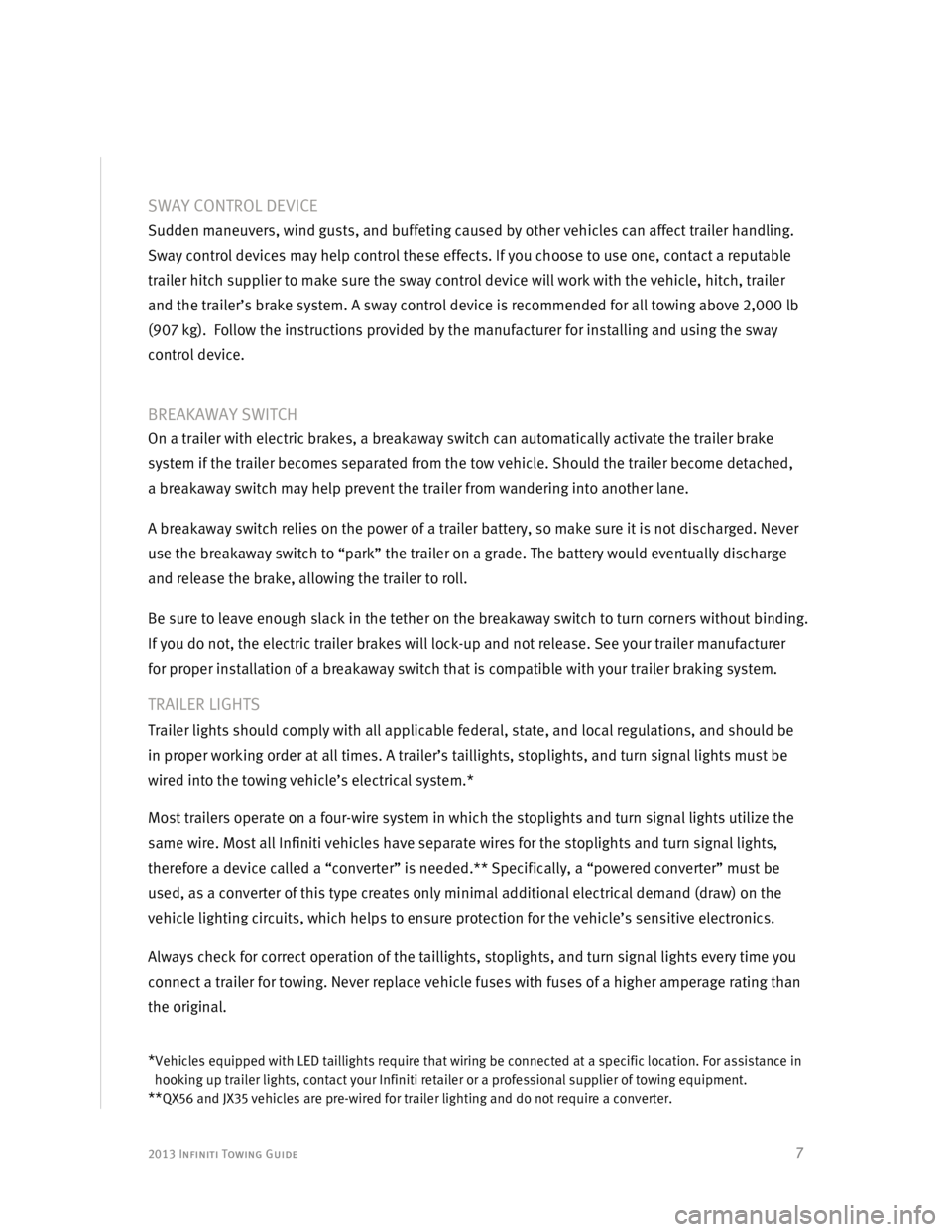
2013 Infiniti Towing Guide
7
SWAY CONTROL DEVICE
Sudden maneuvers, wind gusts, and buffeting caused by other vehicles can affect trailer handling.
Sway control devices may help control these effects. If you choose to use one, contact a reputable
trailer hitch supplier to make sure the sway control device will work with the vehicle, hitch, trailer
and the trailer’s brake system. A sway control device is recommended for all towing above 2,000 lb
(907 kg). Follow the instructions provided by the manufacturer for installing and using the sway
control device.
BREAKAWAY SWITCH
On a trailer with electric brakes, a breakaway switch can automatically activate the trailer brake
system if the trailer becomes separated from the tow vehicle. Should the trailer become detached,
a breakaway switch may help prevent the trailer from wandering into another lane.
A breakaway switch relies on the power of a trailer battery, so make sure it is not discharged. Never
use the breakaway switch to “park” the trailer on a grade. The battery would eventually discharge
and release the brake, allowing the trailer to roll.
Be sure to leave enough slack in the tether on the breakaway switch to turn corners without binding.
If you do not, the electric trailer brakes will lock-up and not release. See your trailer manufacturer
for proper installation of a breakaway switch that is compatible with your trailer braking system.
TRAILER LIGHTS
Trailer lights should comply with all applicable federal, state, and local regulations, and should be
in proper working order at all times. A trailer’s taillights, stoplights, and turn signal lights must be
wired into the towing vehicle’s electrical system.*
Most trailers operate on a four-wire system in which the stoplights and turn signal lights utilize the
same wire. Most all Infiniti vehicles have separate wires for the stoplights and turn signal lights,
therefore a device called a “converter” is needed.** Specifically, a “powered converter” must be
used, as a converter of this type creates only minimal additional electrical demand (draw) on the
vehicle lighting circuits, which helps to ensure protection for the vehicle’s sensitive electronics.
Always check for correct operation of the taillights, stoplights, and turn signal lights every time you
connect a trailer for towing. Never replace vehicle fuses with fuses of a higher amperage rating than
the original.
*Vehicles equipped with LED taillights require that wiring be connected at a specific location. For assistance in
hooking up trailer lights, contact your Infiniti retailer or a professional supplier of towing equipment.
**QX56 and JX35 vehicles are pre-wired for trailer lighting and do not require a converter.
Page 9 of 25
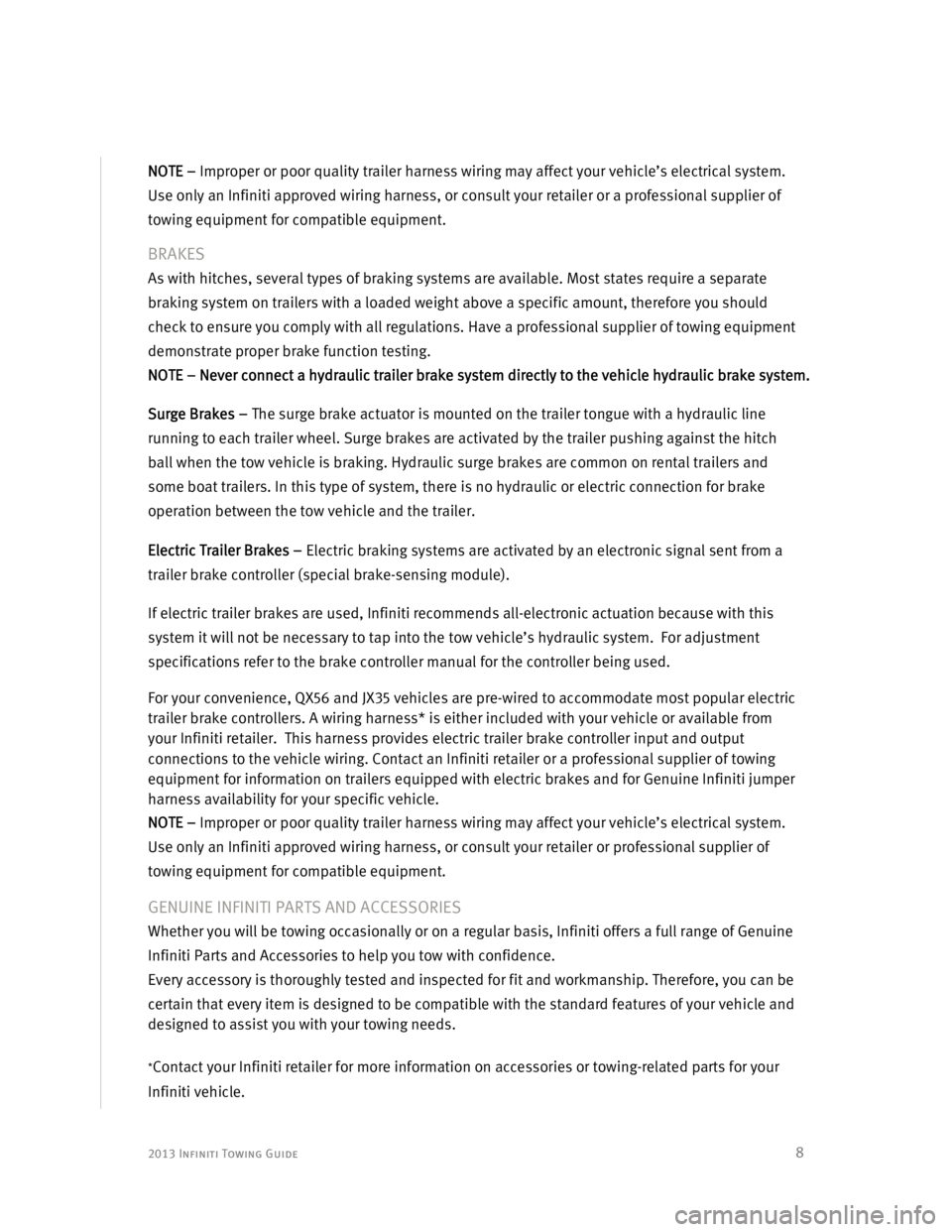
2013 Infiniti Towing Guide
8
NOTE – Improper or poor quality trailer harness wiring may affect your vehicle’s electrical system.
Use only an Infiniti approved wiring harness, or consult your retailer or a professional supplier of
towing equipment for compatible equipment.
BRAKES
As with hitches, several types of braking systems are available. Most states require a separate
braking system on trailers with a loaded weight above a specific amount, therefore you should
check to ensure you comply with all regulations. Have a professional supplier of towing equipment
demonstrate proper brake function testing.
NOTE – Never connect a hydraulic trailer brake system directly to the vehicle hydraulic brake system.
Surge Brakes – The surge brake actuator is mounted on the trailer tongue with a hydraulic line
running to each trailer wheel. Surge brakes are activated by the trailer pushing against the hitch
ball when the tow vehicle is braking. Hydraulic surge brakes are common on rental trailers and
some boat trailers. In this type of system, there is no hydraulic or electric connection for brake
operation between the tow vehicle and the trailer.
Electric Trailer Brakes – Electric braking systems are activated by an electronic signal sent from a
trailer brake controller (special brake-sensing module).
If electric trailer brakes are used, Infiniti recommends all-electronic actuation because with this
system it will not be necessary to tap into the tow vehicle’s hydraulic system. For adjustment
specifications refer to the brake controller manual for the controller being used.
For your convenience, QX56 and JX35 vehicles are pre-wired to accommodate most popular electric
trailer brake controllers. A wiring harness* is either included with your vehicle or available from
your Infiniti retailer. This harness provides electric trailer brake controller input and output
connections to the vehicle wiring. Contact an Infiniti retailer or a professional supplier of towing
equipment for information on trailers equipped with electric brakes and for Genuine Infiniti jumper
harness availability for your specific vehicle.
NOTE – Improper or poor quality trailer harness wiring may affect your vehicle’s electrical system.
Use only an Infiniti approved wiring harness, or consult your retailer or professional supplier of
towing equipment for compatible equipment.
GENUINE INFINITI PARTS AND ACCESSORIES
Whether you will be towing occasionally or on a regular basis, Infiniti offers a full range of Genuine
Infiniti Parts and Accessories to help you tow with confidence.
Every accessory is thoroughly tested and inspected for fit and workmanship. Therefore, you can be
certain that every item is designed to be compatible with the standard features of your vehicle and
designed to assist you with your towing needs.
*Contact your Infiniti retailer for more information on accessories or towing-related parts for your
Infiniti vehicle.
Page 10 of 25
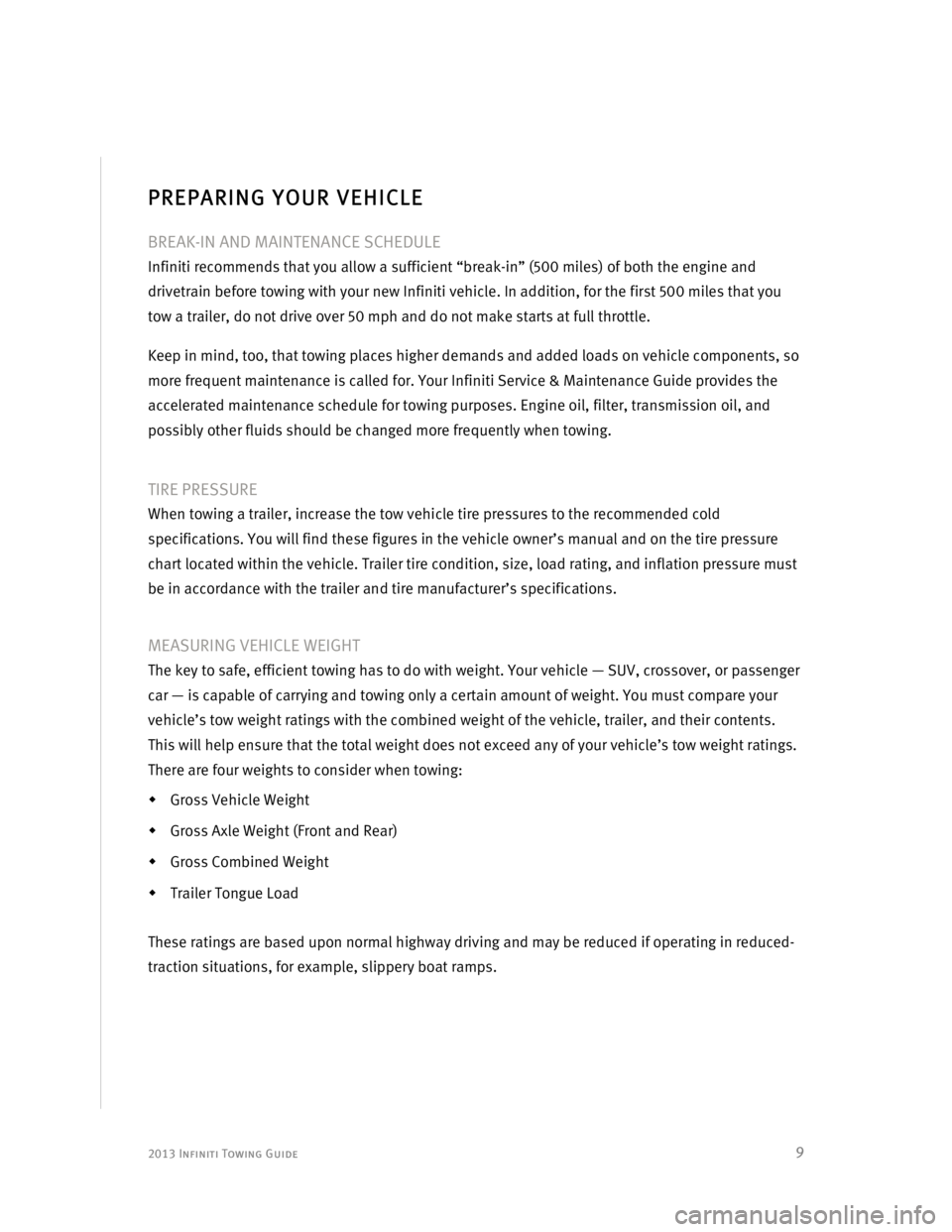
2013 Infiniti Towing Guide
9
PREPARING YOUR VEHICLE
BREAK-IN AND MAINTENANCE SCHEDULE
Infiniti recommends that you allow a sufficient “break-in” (500 miles) of both the engine and
drivetrain before towing with your new Infiniti vehicle. In addition, for the first 500 miles that you
tow a trailer, do not drive over 50 mph and do not make starts at full throttle.
Keep in mind, too, that towing places higher demands and added loads on vehicle components, so
more frequent maintenance is called for. Your Infiniti Service & Maintenance Guide provides the
accelerated maintenance schedule for towing purposes. Engine oil, filter, transmission oil, and
possibly other fluids should be changed more frequently when towing.
TIRE PRESSURE
When towing a trailer, increase the tow vehicle tire pressures to the recommended cold
specifications. You will find these figures in the vehicle owner’s manual and on the tire pressure
chart located within the vehicle. Trailer tire condition, size, load rating, and inflation pressure must
be in accordance with the trailer and tire manufacturer’s specifications.
MEASURING VEHICLE WEIGHT
The key to safe, efficient towing has to do with weight. Your vehicle — SUV, crossover, or passenger
car — is capable of carrying and towing only a certain amount of weight. You must compare your
vehicle’s tow weight ratings with the combined weight of the vehicle, trailer, and their contents.
This will help ensure that the total weight does not exceed any of your vehicle’s tow weight ratings.
There are four weights to consider when towing:
�Š Gross Vehicle Weight
�Š Gross Axle Weight (Front and Rear)
�Š Gross Combined Weight
�Š Trailer Tongue Load
These ratings are based upon normal highway driving and may be reduced if operating in reduced-
traction situations, for example, slippery boat ramps.